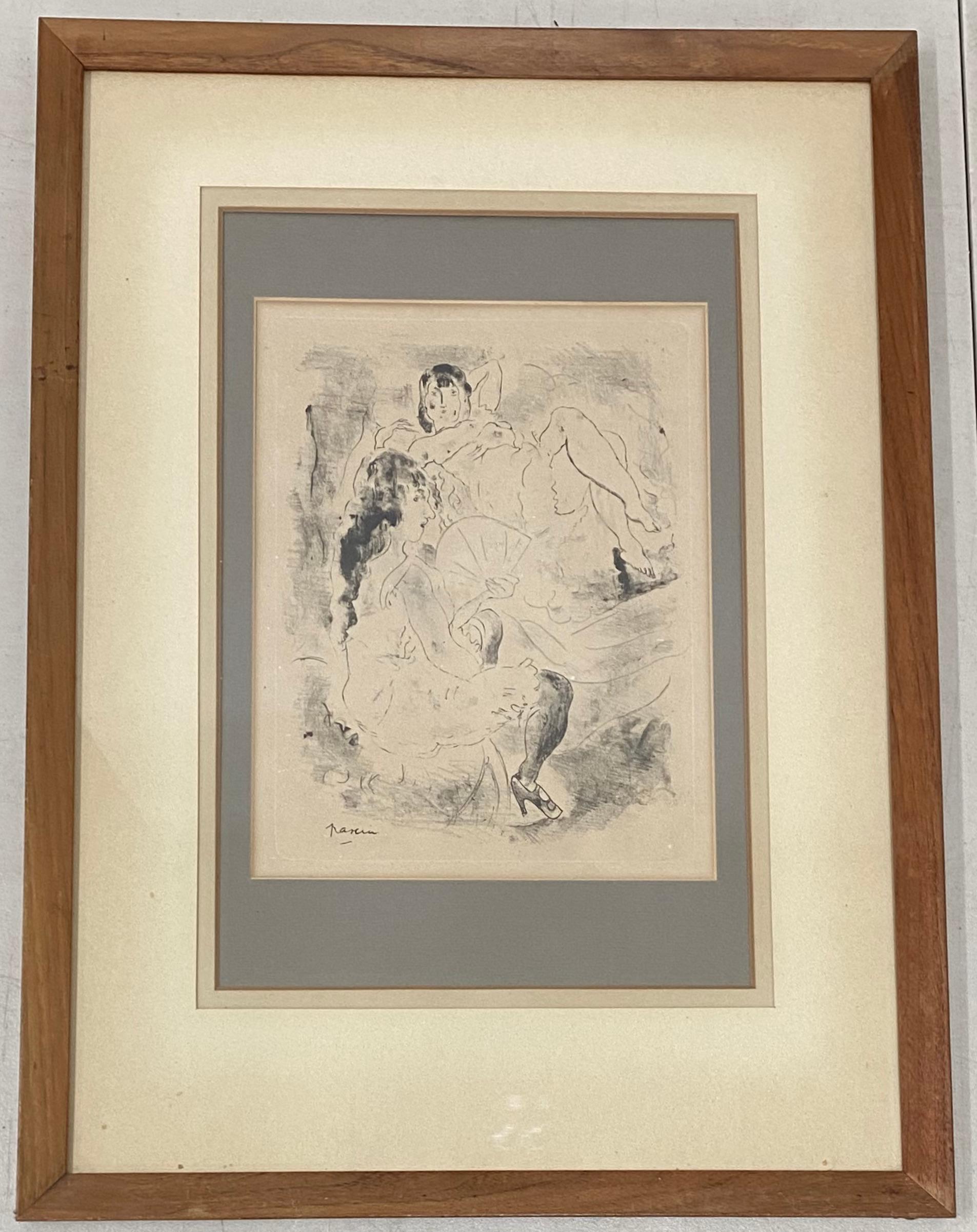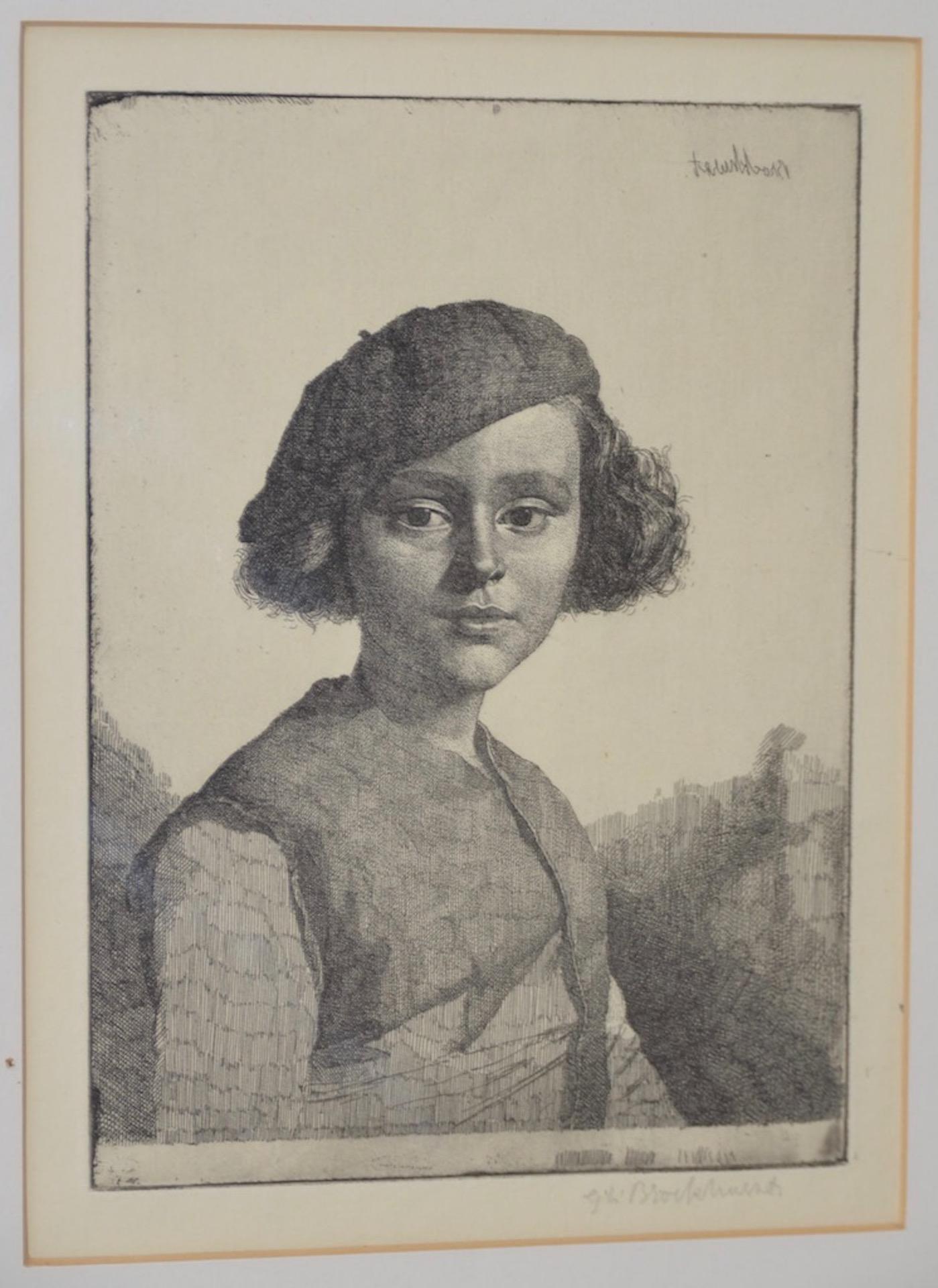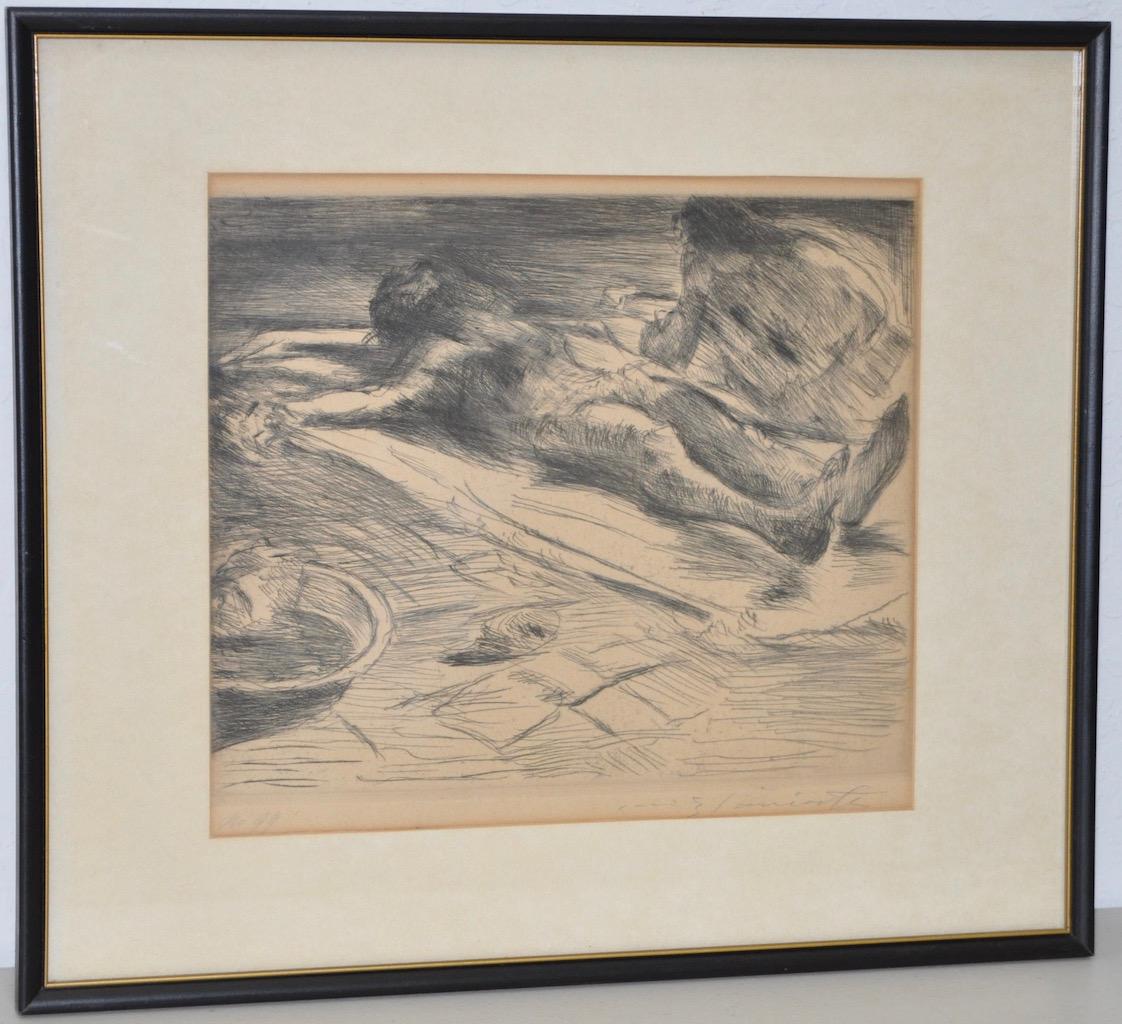Items Similar to Au bord de la mer (At the Sea Side)
Want more images or videos?
Request additional images or videos from the seller
1 of 7
James Jacques Joseph TissotAu bord de la mer (At the Sea Side)1880
1880
About the Item
Au bord de la mer (At the Sea Side)
Etching and drypoint, 1880
Signed in the plate middle left edge (see photo)
Edition: c. 100
A very rich impression, full of burr and contrasts
Printed on medium weight Dutch paper, with a partial Blauw watermark.
This usage of the Dutch paper is indicative of the first printing in London
Reference: Wentworth 47
Provenance: Sagot Heirs
Condition: Excellent
The sheet has appropriate aging for being 140 plus years old
Plate size: 14 7/8 x 5 3/8 inches
Sheet size: 16 1/8 x 6 3/8 inches
Frame: 30-3/4 x 19-3/8 x 1-3/4"
James Jacques Joseph Tissot
Jacques-Joseph Tissot was born in 1836, in Nantes in a seaport on the French coast. Throughout his life Tissot retained an affinity and fascination with all things nautical, and his marked ability to accurately paint rigging and shipboard scene paintings must have come from his boyhood. The son of a prosperous shopkeeper who was a devout Roman Catholic, the young Tissot was sent away to a boarding school run by Jesuits. Although initially unenthusiastic about the prospect of his son becoming an artist, Tissot senior eventually accepted the inevitability of his son's artistic pretensions.
In 1856 Tissot went to Paris to train as a painter. Here, at the Ecole des Beaux Arts the young Tissot met the young James McNiell Whistler (1834-1903), one of the most celebrated and unusual figures in 19th century art. At about this time Tissot also met, and became a friend of Degas (1834-1917) the Impressionist painter. Like Alma-Tadema, and Edward Burne-Jones, Tissot changed his name at this time to draw attention to himself. In his case he anglicized his Christian name to James. Tissot inherited the shrewd commercial instincts of his father, and like Alma-Tadema and Millais, was a painter-entrepreneur. In the 1860s he visited Italy, and in 1862 London. In 1864 Tissot exhibited his oil paintings at the Royal Academy for the first time, suggesting that he realized the potential of London as a source of wealthy patrons. He began to concentrate on contemporary scene paintings. In 1869 he produced caricatures for Vanity Fair magazine, including a brilliant caricature of the elegant, sophisticated Frederic Leighton at an evening reception.
Following the defeat of France and the occupation of Paris during the Franco-Prussian war, Tissot fled to England where he had a considerable number of contacts. He was initially the guest of the Editor of Vanity Fair, with whom he had become friendly, and who seems to have opened doors for him both socially and professionally. Tissot, hard working and shrewd, quickly became successful in London, where his oil paintings of social events and his conversation pieces rapidly became popular. These paintings look beautifully painted and were an interesting record of social life at the time, but were controversial. This was the time when commercially successful people were overtaking the landed aristocracy in wealth and as arts patrons. In some quarters Tissot’s paintings were regarded as depictions of the nouveau-riche. Ruskin was a particularly severe critic, describing them as "mere painted photographs of vulgar society." In 1873, Tissot bought the house in St John's Wood where he would live for the rest of his time in London, and started to become a significant figure socially. Tissot's success in London was regarded with envy by Degas and other painters of his circle in Paris.
In the mid 1870s Tissot met Kathleen Newton (1854-1882), an Irish divorcee with a distinctly colorful past. She had formed a sexual relationship with a man on a voyage to India to be married, and borne his child. Kathleen became Tissot’s model, muse, mistress, and the great love of his life. Many other successful men kept mistresses in St John's Wood, but they did not, like Tissot, live openly with them in adulterous relationships. This situation forced the painter to choose between his social life and Kathleen. To his credit he chose his lady. It would be wrong to think that Tissot became something of a hermit, as he and Kathleen Newton entertained their more bohemian artistic friends at home. But Tissot's days as a man-about-town were over, and he and Kathleen seem to have settled into a quiet life of domesticity. Kathleen's two children lived close by with her sister. Kathleen Newton was an extremely attractive young woman, and appeared in many of Tissot paintings at this time. In the late 1870s her health started to decline, with the onset of that great 19th century killer Tuberculosis. Tissot remained devoted to her. It is likely that the Roman Catholicism of both would not allow them to contemplate marriage. In 1882, the desperately ill Kathleen cheated consumption by committing suicide, and, as a result was not able to be buried in consecrated ground. With one week Tissot left his home at St Johns Wood, and never returned to it. The house was later bought by Alma-Tadema.
Tissot was devastated by his loss, and never really recovered from it. He seemed unable to accept the enormity and permanence of it. It is rumored that he considered marriage to other women later in life, but these affairs came to nothing. Like many English people at this time Tissot became interested in Spiritualism, and on a number of occasions tried to contact the dead Kathleen. The exotic French artist and his fallen women-one of the great 19th century English love stories. Initially Tissot carried on working back in Paris, in much the same manner as in London. Tissot produced a series of paintings of attractive, beautifully dressed women in sumptuous surroundings. These paintings were, for a time, extremely fashionable. Following this Tissot experienced a profound religious experience, and became increasingly devout. Tissot embarked on a series of religious paintings, visiting the Middle East on a number of occasions, to observe and paint backgrounds for his oil paintings. These paintings were well-received at the time, but in our more secular age have little appeal. James Tissot died on Friday 8th August 1902. Courtesy: James Tissot web site
- Creator:James Jacques Joseph Tissot (1836-1902, French)
- Creation Year:1880
- Dimensions:Height: 16.13 in (40.98 cm)Width: 6.38 in (16.21 cm)
- Medium:
- Movement & Style:
- Period:
- Condition:
- Gallery Location:Fairlawn, OH
- Reference Number:
About the Seller
5.0
Recognized Seller
These prestigious sellers are industry leaders and represent the highest echelon for item quality and design.
Platinum Seller
These expertly vetted sellers are 1stDibs' most experienced sellers and are rated highest by our customers.
Established in 1978
1stDibs seller since 2013
711 sales on 1stDibs
Typical response time: 1 hour
Associations
International Fine Print Dealers Association
- ShippingRetrieving quote...Ships From: Fairlawn, OH
- Return PolicyA return for this item may be initiated within 10 days of delivery.
More From This SellerView All
- Afternoon Tea PartyBy (after) Mary CassattLocated in Fairlawn, OHAfternoon Tea Party Drypoint and aquatint printed in colors, printed 1991 Initialed in the center of the plate Condition: Excellent Archival framing with silk matting, finished corner gold...Category
1890s Impressionist Figurative Prints
MaterialsAquatint
- Le Gamin (The Kid)By Édouard ManetLocated in Fairlawn, OHLe Gamin (The Kid) Etching on laid paper, 1862 Signed in the plate upper left (see photo) As published in Theodore Duret, L'Histoire d'Edouard Manet et de Son Ouvre, 1902 (The first ...Category
1860s Impressionist Figurative Prints
MaterialsEtching
- Trois Esquisses de maternite (Three Studies of Maternity)By Pierre Auguste RenoirLocated in Fairlawn, OHAfter Pierre Auguste Renoir (1841-1919) Trois Esquisses de maternite (Three Studies of Maternity) Heliogravure with etching on velin paper, 1893 Unsigned as issued Edition 1000, there are also 100 on a different paper Note: The original red and white chalk drawing is in the collection of th Art Gallery of...Category
1890s Impressionist Figurative Prints
MaterialsEtching
- L'enfant prodigue: en pays etranger (The Prodigal Son: In Foreign Climes)By James Jacques Joseph TissotLocated in Fairlawn, OHL'enfant prodigue: en pays etranger (The Prodigal Son: In Foreign Climes) Etching, 1881 Unsigned (as usual for this state) From: L'enfant prodigue, (The Prodigal Son, five plates) Ed...Category
1880s Impressionist Figurative Prints
MaterialsEtching
- AvrilBy Manuel RobbeLocated in Fairlawn, OHAvril (April) Color aquatint and etching, c. 1906 Signed in pencil lower right Edition: c. 100 Excellent impression, fresh colors Reference: Merrill Chase Volume 1, No. 9 Condition: ...Category
Early 1900s Impressionist Figurative Prints
MaterialsAquatint
- Noon Time LullBy Louis Oscar GriffithLocated in Fairlawn, OHNoon Time Lull Etching, c. 1930 Signed by the artist in pencil lower right (see photo) Note: An image done in South Carolina. An impression of this image is in the permanent collecti...Category
1930s American Impressionist Figurative Prints
MaterialsEtching
You May Also Like
- "Le Portique de la Galerie Nationale a Londres" etching by TissotBy James Jacques Joseph TissotLocated in Hinsdale, ILTISSOT, JAMES JACQUES JOSEPH (1836 - 1902) "Le Portique de la Galerie Nationale a Londres" (The Portico of the National Gallery, London) Wentworth 40 Etching and Drypoint on imitation Japanese paper, C. 1878 Only state published, from the edition of 100 Signed 1878 J.J. Tissot on the step, lower right 14 7/8” x 8 1/4” Excellent crisp impression This etching is related to the painting London Visitors exhibited at the Royal Academy in 1874, no. 116. The setting is the portico of the National Gallery, looking toward the Church of St. Martin’s-in-the-Fields. Such works give Tissot a minor but distinguished position as a predecessor of the school of architectural etchers...Category
Late 19th Century Impressionist Figurative Prints
MaterialsEtching
- Jules Pascin (French, 1885-1930) "Two Women Reclining" Original Etching C.1920By Jules PascinLocated in San Francisco, CAJules Pascin (French, 1885-1930) "Two Women Reclining" Original Etching C.1920 Plate dimensions 9" wide x 12" high Frame dimensions 19.5" wide x 26.5" high Plate signed The etchi...Category
Early 20th Century Impressionist Figurative Prints
MaterialsEtching
- Gerald Brockhurst (1890-1978) "Fabian" Pencil Signed Etching c.1921By Gerald Leslie BrockhurstLocated in San Francisco, CAGerald Brockhurst (1890-1978) Pencil Signed Etching "Fabian" c.1921 Fine etching by noted artist Gerald Brockhurst. Titled "Fabian" from an edition of 76. This etching is in excel...Category
Early 20th Century Impressionist Portrait Prints
MaterialsEtching
- Lovis Corinth (German, 1859-1925) "Pieta" Rare Etching c.1920By Lovis CorinthLocated in San Francisco, CALovis Corinth (German, 1859-1925) Rare Etching c.1920 Fine etching by noted German Expressionist artist Lovis Corinth. This striking imag...Category
Early 20th Century Impressionist Figurative Prints
MaterialsEtching
- Dance at Gopsmor /// Impressionist Swedish Anders Zorn Etching Party AntiqueBy Anders ZornLocated in Saint Augustine, FLArtist: Anders Zorn (Swedish, 1860-1920) Title: "Dance at Gopsmor" *Signed by Zorn in pencil lower right. It is also signed and dated in the plate (printed signature) lower left Year: 1906 (second state of two) Medium: Original Etching on cream Van Gelder Zonen laid paper Limited edition: approx. 50 impressions Printer: the artist Zorn himself, Mora, Sweden Publisher: the artist Zorn himself, Mora, Sweden Reference: Asplund No. 197; Hjert & Hjert No. 205; Loys Delteil No. 192 Framing: Recently framed in a gold ornate moulding and fabric matting from Holland. All archival Framed size: 22.75" x 18.25" Sheet size (irregular margins): 16.5" x 11" Image size: 11.88" x 7.75" Condition: A strong impression in very good condition Very rare Notes: Provenance: private collection - Chicago, IL; acquired from Rothschild & Company, Chicago, IL in the early 1900's. Fleur-de-lis shield with text underneath (Van Gelder Zonen) watermark in center of sheet. "Towards the end of the nineteenth century and at the beginning of the twentieth century, Anders Zorn became increasingly interested in the history and ancient traditions of his native town Mora and its wider cultural territories which at the time, as a result of industrialisation and urbanisation, were begining to disappear. In 1904, Anders Zorn purchased an ancient farmhouse which he moved to the parish of Gopsmor, situated by the river Dal, North-West of Mora. The simple ritualistic lifestyle of its people, with whom he felt affinity, and Gopsmor's geographical isolation, became for Zorn, a place of refuge for the cosmopolitan artist". - Christie's, London, UK Biography: Anders Leonard Zorn...Category
Early 1900s Impressionist Figurative Prints
MaterialsLaid Paper, Etching, Intaglio
- Le Bouquet de Violettes (The Bouquet of Violets) /// Figurative ImpressionistBy Manuel RobbeLocated in Saint Augustine, FLArtist: Manuel Robbe (French, 1872-1936) Title: "Le Bouquet de Violettes (The Bouquet of Violets)" *Signed by Robbe in pencil lower right Year: 1903 Medium: Original Hand-Colored Etc...Category
Early 1900s Impressionist Figurative Prints
MaterialsEtching, Aquatint, Watercolor, Laid Paper, Intaglio
Recently Viewed
View AllMore Ways To Browse
Christian Dior Lady Black
Black Train Case
Dior Lady Dior Medium
Christian Dior Lady Dior Medium
Black Antique Photo Frames
Irish Sea
St Joseph Antique
Antique Doors India
Religious And Christian
Tissot Used
Antique Black Vanity
Black Antique Vanity
French 3 Door Painted
Little Black Dress Painting
Antique Nautical Signs
Antique Nautical Sign
St Johns Dresses
French St Joseph





